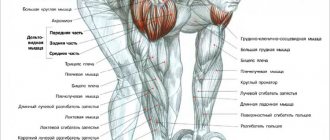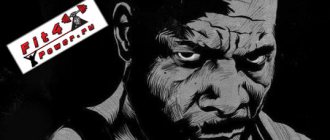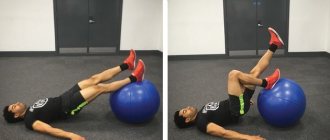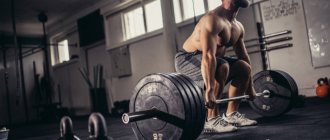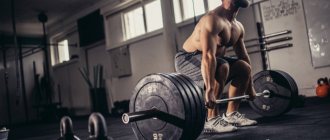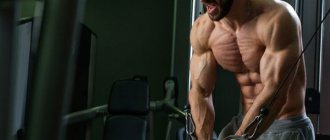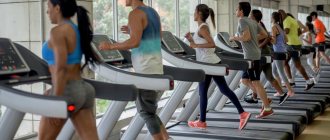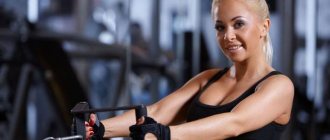When it comes to the most iconic figure in the field of fitness, many experienced athletes first remember Joe Weider. And this is not surprising, because it was he who made bodybuilding as we know it now. In our article today, we will share with you Joe Weider’s training program, and also tell you in detail about its basic principles. Interested? Then start reading quickly!
Biography
You can’t talk about Joe Weider’s muscle-building training program without saying something about him.
Joe Weider was born on November 29, 1919 in Montreal. His interest in iron sports began when he was a skinny teenager. Joe had a frail physique, and many experienced athletes refused to train him because they were afraid that he might be seriously injured. Despite this, Vader did not stop and continued to pursue his dream: he built his first barbell from a locomotive axle and car wheels.
Already at the age of 17, Joe began publishing his own magazine called Your Physique, which today is published under the name Muscle & Fitness. After WWII, Joe Weider, together with his brother Ben, began to actively popularize iron sports in and outside the United States. It was they who founded the Mr. Olympia competition and opened the International Bodybuilding Federation. Joe and Ben Weider trained such famous athletes as Arnold Schwarzenegger, Lou Ferrigno, Larry Scott and many others.
Betty Brosmer
Anyone who is involved in bodybuilding, bodybuilding, athleticism is not important. At least once, I have seen, on the Internet, in magazines or films about bodybuilding, photographs of bodybuilders with a girl. The girls, of course, were different. But there was one among them who stood out against their background with a very thin waist. There were many photographs of her. There were even more bodybuilders eager to film with her.
Young Arnold Schwarzenegger and Betty Brosmer posing for Joe Weider magazines
The girl's name was Betty Brosmer and she was Joe Weider's wife. But first, she was a model for various kinds of magazines. She has held various titles in California from “Miss Jones Beach” to “Miss Potato Chips.” She earned good money from a young age, loved antiques and was in great demand in the world of fashion and advertising.
Joe Weider Training Program: Principles
Before you get acquainted with the training system itself, you first need to know its principles. Joe Weider's training program involves three gradations:
- For beginner athletes. Designed for two months with training three times a week (Monday, Wednesday, Friday).
- For athletes with an average level of physical fitness. A more flexible approach to working weights is expected.
- For professional athletes. The basic principle is large working weights, a small number of sets and repetitions.
The main principles developed by the Vader brothers:
- “Shocking” the muscles. According to Ben and Joe Weider, muscles should not get used to the load, since in most cases it is habituation that is the main cause of stagnation.
- Muscle isolation. To put it in the simplest possible terms, the principle of muscle isolation is the use of all sorts of tricks in order to get to all muscle bundles.
- "Pyramid". The pyramid is a principle, the essence of which is to gradually perform an exercise from the minimum working weight to the maximum.
- Cheating. Cheating is a method of performing an exercise in which an athlete uses jerks, pushes and other not entirely honest methods to press/lift a heavy weight.
Now the principles of Joe Weider's training program seem somewhat obvious, but at that time this knowledge was revolutionary.
Success
The magazine "Your Physique" began to be published regularly, and subsequently he launched a whole series of different magazines.
Next was Muscle Power, which he launched in 1945, and then others - Men's Fitness, Shape, Muscleboy and Monsieur (the latter was exclusively for perverts) began to appear on store shelves.
All of Vader's articles were distinguished by his characteristic animated tone and loud headlines “Hey, thin!” or “Are you tired of your weakness?”
This unique style led to widespread success, and Vader's empire expanded.
He also launched other equipment and sports nutrition businesses, all of which he advertised in his own magazines.
Weider also authored many books on bodybuilding, such as The Weider Bodybuilding System (1981).
To give you an idea of the monopoly Vader created in this industry, just imagine: in 2003, he sold his empire for $357 million!
Program for beginners
Attention! It is important to understand that each person needs an individual approach when it comes to training. It is possible that this training system will not suit you.
According to Joe Weider's training program for beginners, during the first month the athlete must perform one set of each exercise with breaks of 1-2 minutes. With each workout you need to increase the working weight of the equipment, but this must be done gradually and slowly. If you feel that the exercise is too easy for you and you can perform more than 12 repetitions with good technique without any difficulty, then it's time to increase the weight.
At the end of the first month of sports activities, you can take a 3-4 day break from training. This will help the new athlete recover properly and give him the motivation to get back to training as soon as possible.
The second month of Joe Weider's training program for beginners is almost identical to the first, but the only difference is that now you need to perform one more set of exercises. The break between sets is approximately one minute, the break between exercises is 1-2 minutes.
Joe Weider's training program for girls is presented in the video below.
Nutrition
Whatever sport you choose, 60% of success will depend on proper nutrition. Here are three basic rules that must be followed according to Joe Weider :
- It is necessary to carefully monitor the quality of food consumed . It is important that the diet includes all the main components.
- Properly distribute your calorie sources : 60% - carbohydrates . Moreover, it is advisable to eat natural carbohydrates. They give our body the necessary energy that maintains our vitality throughout the day. They are also necessary for restoring glycogen in muscles. 20-25% – plant and animal proteins (preferably with less fat). Protein is needed to produce energy and repair muscle fibers that are stretched during training, and also allows you to build muscle mass faster. 25-30% - fats. They maintain normal blood viscosity. In addition, they promote the production of hormones and the supply of vitamins and energy. In addition to all of the above, in between meals, you need to eat a portion of vegetables and fruits, and also drink 2-3 liters of water per day .
- Nutrition should suit your body type . Beginners need to reduce the amount of fat and, conversely, increase their protein intake.
Igor December 29, 2010
Training plan: day one
Let's look at the training plan for the week. The following exercises are performed on Monday:
- Bench press in a horizontal position. The grip is average.
- Raising arms with dumbbells in a horizontal position.
- Pullover with a barbell.
- Barbell curl for biceps in a standing position.
- French press with a barbell. The grip is narrow.
- Bent-over barbell row to chest level.
- Dumbbell flyes in a standing position. The body should be tilted.
- Dumbbell front raises for the front deltoid in a standing position.
- Exercise for the neck: put your hands on the back of your head, pull your head back, overcoming the resistance of your hands.
- Barbell lifts with a straight forearm grip.
- Squats.
- Standing calf raises with a barbell on your shoulders.
- Lying leg raises.
Tuesday is a day off.
External links [edit]
| Wikimedia Commons has media related to Joe Weider . |
- Official Joe Weider website
- Weider Fitness Official Website
| vteMr. Olympia competition | |
| |
| vteMiss Olympia competition | |
| |
| Authoritative control |
|
Training plan: day two
Wednesday exercises include:
- Bench press in a horizontal position. The grip is wide.
- Alternating dumbbell bicep curls while seated.
- Alternating French press with dumbbells in a seated position.
- Exercise for the neck: put your hands on the back of your head, pull your head back, overcoming the resistance of your hands.
- Broaching with a barbell. The grip is narrow.
- Lifting the barbell in front of you with straight arms in a standing position.
- Barbell lifts with a straight forearm grip.
- Rowing a barbell to the chest while standing bent over with a wide grip.
- Shrugs with a barbell.
- Squats.
- Hackenschmidt squats
- Calf raises with a dumbbell in hand using an elevated platform.
- Bend to the sides with a weight in your hand.
- Raising the body in a lying position.
Thursday is a day of rest.
Training plan: day three
On Friday you need to perform the following complex:
- Bench press in a horizontal position. The grip is average.
- French press with a barbell.
- Barbell curls for biceps.
- Alternating triceps raises while standing on an incline.
- Army press.
- Raising the barbell to the chest.
- Dumbbell row for the latissimus muscle.
- Leg raises with weights in a lying position.
- Body bends with a dumbbell behind your head in a standing position.
- Exercise for the neck: put your hands on the back of your head, pull your head back, overcoming the resistance of your hands.
- Lifting the barbell for biceps with a straight grip.
- Front squats with a barbell.
- Walking on your toes with a barbell on your shoulders.
Saturday and Sunday - the athlete rests.
Text of the book “Bodybuilding without steroids”
The Natural Training Path
In this book, we mentioned Eugene Sandow, whose body is immortalized in a statuette that is awarded to the winner of the Mr. Olympia competition as the highest award in bodybuilding.
But besides Sandow, there were athletes who performed in the circus, whose physique deserved the title of standard. All wrestlers (not to mention the athletes who lifted weights in the arena) were constantly and purposefully engaged in strength training. The equipment at their disposal was not very advanced: weights, ball bars, etc.
Each athlete worked out differently. However, it cannot be said that the system as a whole was absent.
Sandow's book Bodybuilding was published in London in 1903. It put forward the concept of “building the body” and outlined its principles, which later formed the basis of bodybuilding.
Sandow's system included 18 dumbbell exercises; in the methodological manuals accompanying them, the principle of gradual increase in loads was observed. There is no doubt that Sandow's manuals played a positive role in the development of modern views on strength training techniques.
The system of the Frenchman de Bonnet, who developed a training program consisting of 17 exercises, was also quite famous among specialists. The advantages of this system include the fact that after each exercise with weights it was recommended to perform floor exercises without equipment for stretching and relaxation.
As his popularity grew, Sandow built an entire industry around himself. Through books, magazines, and the production of sports equipment, he promoted a healthy lifestyle.
Sandow was the first to hold competitions where the development of figures of athletes in various sports was assessed. The winner received a statuette of Eugene Sandow as a reward. Despite Sandow's sudden death in a car accident in 1925, competitions to demonstrate the beauty of the human body continued and became traditional.
Sandow was followed by ex-wrestler Bernard McFadden, who founded America's first bodybuilding magazine called Physical Culture. He also held a sports competition for men in America. The winner, Al Trelor, received a thousand-dollar prize and the title of "America's Most Magnificently Built Man." In Europe, the first athletic competition took place at the Albert Hall in London in 1905.
The next prominent bodybuilder was Angello Siciliano in 1922, performing under the pseudonym “Charles Atlas.”
And yet, the founding fathers of bodybuilding were the Weider brothers - Joe and Ben.
Joe Weider system
Joe Weider is the guru of modern bodybuilding, who trained many champions. He managed to put a lot of things on stream, not only the training of champions... It was he who, by investing $7 in start-up capital in those early years, was able to build a huge empire of bodybuilding and fitness with an annual turnover of half a billion dollars.
The beginning of this story dates back to the 30s of the last century. Two puny Jewish boys from Canada
the city of Montreal, brothers Joe and Ben Vader, were always beaten in any street brawl with their peers. Joe soon realized: to get less, you have to be stronger. But how, if from birth you are not endowed with weighty fists and great health?
Joe Weider
It was extremely difficult to find dumbbells in Montreal in those days. But Joe dragged an axle from a locomotive from the landfill. The next time the brothers found metal wheels from a trolley here. And the training began! Success was not long in coming. Soon Joe wins a local weight lifting competition. “How did you achieve this?” - people asked when they met Joe. Soon he began receiving similar questions by mail. And 17-year-old Joe Weider decides to answer everyone at once by releasing the brochure “Your Physique” (the founder of the magazines “Flex” and “Muscle & Fitness”). A month later it turned out that 50 thousand printed copies were clearly not enough. This was the beginning of what Joe and his younger brother Ben would do for the next 60 years of their lives. Throughout the post-war years, the brothers intensively popularized bodybuilding.
Ben and Joe Weider founded the International Federation of Bodybuilders (IFBB) in 1946, which currently unites 183 national associations. The Vader brothers not only developed a special set of exercises for building muscle mass. They also promoted the idea of a special diet for bodybuilders, including vitamin and nutritional supplements. The company founded by the Vaders for the production of products for bodybuilding athletes has long been a monopolist in this industry.
This is what Joe Weider writes in his book: “My system is the most popular and effective athletic training course in the world. As a result of my 50 years in this sport, Joe Weider's system has become the basis for all modern techniques used in athleticism and weight training. Literally everything in athleticism comes from Joe Weider's system. My system has stood the test of time! The results speak for themselves.
It is no coincidence that Joe Weider's system is so popular. The champions I helped train, winners of all the highest athletic titles. My famous stars include Arnold Schwarzenegger (seven-time Mr. Olympia), Frank Zane (three-time Mr. Olympia), Sergio Oliva (three-time Mr. Olympia), Larry Scott (two-time Mr. Olympia), Franco Colombo (two-time Mr. Olympia"), Chris Dickerson ("Mr. Olympia"), Raquel McLeish ("Ms. Olympia"), Lou Ferrigno ("Mr. America", "Mr. International" and twice "Mr. Universe"), Corinne Everson (US women's champion and three-time Ms. Olympia), Lee Haney (USA, world champion and three-time Mr. Olympia).”
No one has tried to challenge Joe Weider's claim that literally everything in athleticism comes from his system.
Weider considers the technical side to be an important milestone in the history of athleticism: “If you did not have sufficient physical strength before starting training, you would not have been able to purchase weights anywhere whose weight would correspond to your capabilities, and moreover, it could be increased and decreased according to your needs.” at your own discretion.
This obstacle was removed at the beginning of the twentieth century, when Alan Colvert introduced collapsible, disc-loaded barbells and dumbbells to the American public. For the first time, ordinary men and women had the opportunity to train with weights, and the sport began to grow in popularity.”
But it’s true - the machine gun was invented twenty years earlier than collapsible barbells and dumbbells!
However, improved projectiles did not solve everything:
“Even though equipment was improving at an astonishing rate, the courses and instructions included with weight sets were based on outdated, nineteenth-century European exercises and training methods. It was as if no one was willing to do the research necessary to improve upon the ancient methods that were in use, mainly because the so-called experts of the day were wary of resistance training.
As a result, athleticism remained a hit-and-miss affair for many years. Weightlifters became champions who developed their bodies by performing basic strength exercises. But even the greatest athletes of those times, nevertheless, could not achieve such anthropometric indicators and such a level of strength that are now considered ordinary among Joe Weider's students who have been training for less than three years!
Here Joe Weider, I must say, went too far. We know how much, for example, Louis Uni, nicknamed Apollo, raised back in 1899. And Charles Rigoulot's records are also impressive. Many have also heard about our compatriot Alexander Zass (Samson). This athlete, whose weight did not exceed 80 kg, carried around the arena a horse or a piano with a pianist and dancer located on the lid.
But Vader is famous for the perfect, thoughtful, experimentally tested - by himself and his first students - training system: “My most significant work was the synthesis of all the collected material and the creation of a comprehensive, easy-to-understand training system. From this problem grew the idea of the Joe Weider System, as well as my desire to publish athletic magazines superior to any the world had ever seen. I have dedicated my entire life to these two goals.
Not having the opportunity to personally test all my theories, I enlisted the help of friends and all the champion athletes. Taking the results of our work as a basis, I developed certain training methods - “super series”, “giant series”, “rest-pause”, etc.”
This system can be considered fully established since 1938, when Joe Weider took second place at the Mr. Canada competition, losing only half a point to the winner. And the winner was... Joe Weider's student.
In those years, not only the Joe Weider system was born. He founded the Joe Weider Empire: “Knowing that I had something very important to tell the world, in 1940 I began publishing the magazine “Your Figure.” It was soon followed by the periodicals Muscle Power, American Men, Mr. America and, finally, Building Muscle and Power - all devoted to athletic sports. Today, Building Muscle and Power has evolved into Muscle and Conditioning, the world's premier athletics and weight training magazine, recognized by champions, experts and the interested public as the "athlete's bible."
In my own journals, with millions of students, with the collaboration of some of the world's best built men, and with dedicated scientists, I have been able to accumulate material on every phase of weight training and athleticism. In fact, this research was of such tremendous proportions that I was forced to form the Joe Weider Research Group, whose main function was to develop new, more advanced athletic programs and training equipment. Joe Weider's bodybuilding system"/).
Before continuing with further quotation, it is necessary to recall the instructions of Joe Weider. Let's highlight this text: “I insist that you do not deviate in any way from the instructions outlined here until you have thoroughly mastered the Joe Weider system, and especially the principle of Joe Weider's instinctive training. Each element of your training outlined here has a strictly defined purpose, and solely in your interests.”
How do I personally feel about the Vader system? Guided by two rules: “Do not make yourself an idol” and “There is no Panacea (all-healing medicine).” But Vader's system should be studied. And very carefully.
So let's start reading.
How to train
“Remember that exercise alone does not increase muscle mass. Factors that must also be taken into account include diet, the amount of sleep and rest you give yourself, your general routine, etc. Later in this tutorial, you will learn everything you need to know about sleep, diet, nutrition, and health control. emotions.
I want you to train every other day at first: Mondays, Wednesdays and Fridays or Tuesdays, Thursdays and Saturdays. You should exercise regularly three days a week for the first three months. After this, you can increase the number of your classes to 4-5 per week. Overall, consistency in training is the key to success.
How to get the best results from the training:
• make sure you get enough sleep and rest;
• initially train three times a week every other day; • adjust your pattern so that you exercise at the same time each time;
• eat good quality and properly prepared food, rich in proteins, vitamins, minerals and unrefined carbohydrates;
• drink more clean water (at least 12–16 225 gram glasses per day);
• Constantly tell yourself that you will succeed in creating the body you have always wanted.”
In general, no discoveries have been made yet, but I already want to argue with something.
Three workouts a week is enough, the whole point is how much load the person doing these workouts will withstand. We will return to this issue later. Where to Train
“Since you purchased Joe Weider's book, you have undoubtedly decided to conduct athletic training at home. A home gym provides privacy and the ability to train in a way that suits you. Most of the current champion athletes began training at home. A good example is Lou Ferrigno, who trained for three years in the basement of his parents' home in Brooklyn before venturing into a public gym. And Franco Colombo, a chiropractor, won the Mr. Olympia competition after training in his garage!”
In general, I personally prefer privacy and lack of fuss. All that super fancy, shiny nickel and chrome equipment in the training rooms costs money - hence the rent. And since the rent is high, it means that every student will definitely consider that others are “stealing” their approaches. Of course, they steal - especially those for whom the training room is a place where, first of all, they need to show themselves, and also “pick up a girl (guy).”
Here's a quote from Brooks Kubik's book "Dinosaur Training":
“The reason why modern training is unproductive is very simple - most weight trainers today are simply not interested in serious results. Most of those who pump iron today do so for reasons far removed from the desire to develop fearsome physical strength and unbridled primal power. These are the kind of people we are happy to see in modern gyms. I will say more - in fact, only such visitors are what modern fitness clubs are interested in.
The “ideal” visitor, from the point of view of the gym administration, is the one who, after spinning the pedal of an exercise bike a little in one corner of the hall, then goes to another corner to tug a little on the handles of some exercise equipment, and, in the end, maybe Maybe he will lift some light, very light weight. Today's gyms are aimed at visitors who go there to chat with friends or “pick up” a girl they like. And the LEAST thing the administration of such a gym needs are lovers of serious training.
A typical gym is simply filled with unnecessary exercise equipment, most of which can only be called “functional” with a very big stretch - as if they were designed by a baboon and assembled by an orangutan. If these exercise machines have a function, then it is one - to seduce visitors, make them fork out for a gym membership, where they will be able to reap the “fruits” of training on the machines that the instructors (who, in turn, are no one else, as "haloed" salespeople) will say that these are the "newest" and "most scientifically and technologically advanced" simulators on the market.
Ninety percent of the equipment in the average gym can be melted down or scrapped without much damage.
Well, what else takes up space in a regular hall? The typical instructor is a brainless oaf who doesn’t have even the slightest hint of what productive training is.”
Although Brooks is harsh in his judgments, even rude, but, in general, he is right.
We will tell you about this athlete below. Cautions
“Most beginner athletes, in order to look more impressive, crave rapid development of the muscles of the arms, chest and shoulders. Sometimes these people do not follow the sequence of my course, instead specializing in pumping up the named muscle groups. You shouldn't do this. Never neglect training your leg muscles or any other part of your body.
The purpose of specialization is to bring lagging muscle groups to a general level. It takes a minimum of six months of systematic, hard training before lagging areas are discovered. From now on you can specialize them, but not before!
I insist that you follow these instructions. If you do otherwise, don't expect to make any progress in your athletic pursuits. In addition, it is possible that your figure will become unbalanced and shapeless, which defeats the purpose of this course and is equally not a symbol of a champion’s physique.”
This requires some clarification. It would seem that the bodybuilding guru is grumbling about trifles. A person wants to have a powerful chest and shoulder girdle - so what’s wrong with that? Everyone ultimately chooses their own path. The athlete trains for himself, and not in order to once again advertise the Vader system.
Not everything is so simple, it turns out. What Vader strongly recommends doing in the first stage of preparation is called "base". And there is also “split”. The term "split" when applied to training literally means "dividing into parts." The split system emerged at a time when bodybuilders stopped training all muscle groups on one training day and began working individual muscle groups on different training days.
Modern “jocks” argue fiercely about what part of the training process should be occupied by “split” and what part by “base”.
Personally, I would advise you to listen to Vader, who raised many champions.
How to Perform the Exercises
“You should move the weight through the full range of motion for each repetition of the exercise. Otherwise, you will only deceive yourself and will not achieve full development of your muscles.
In the first 3-6 months of training, it is absolutely necessary to perform each repetition cleanly, that is, without the help of other parts of the body. This means that you should not push with your legs or bend your torso to bring the weight to its final position. This type of deception robs your working muscles of much of the work they need to grow faster.
Later, as you become more experienced, you can begin to use this form of “cheating” to make the exercise more difficult for your working muscles. Beginning athletes, of course, invariably resort to “cheating” (cheating in translation just means cheating) in order to make it easier to perform the exercise, while they need to concentrate on accurately performing repetitions in each approach. The main thing is to develop the right habits from the very beginning.
Don't fool yourself. It is important that during the training you try to form a mental-muscular connection. Concentration ensures that you use all muscle fibers, maintain proper movement form and do not injure yourself.”
Have you noticed the development of the mental-muscle connection? This is not only the development of technology - it is something more. Many people have probably heard that if you exercise only one arm, the other arm will also develop - that is, the muscles on it will also grow, although not as intensely as on the one being trained.
What is cheating?
Let's say you're doing a barbell curl with an underhand grip. Since this exercise works quite small muscles (namely, biceps and deltoids), they get tired quickly. If you flex your hips slightly when the bar is at its lowest point, you will add additional momentum to the bar. As the bar moves to the top point, you can bend slightly back at the lower back. This way, you're pushing your biceps and deltoids to their limit (which, as we'll see later, is very important!). Training Tempo
“I would like you to rest only 60-90 seconds between sets. A fast training pace will keep your body warm during the session, you will not be at risk of injury and will maintain increased blood flow to the muscles; this way you will become bigger and stronger.
Another aspect of training tempo is how quickly you lift and lower the weight. As a rule, when performing an exercise, for example, with a barbell, you spend 2-3 seconds lifting and 4 seconds lowering the apparatus.
Why is it so important to train at this pace? By performing the exercise slowly and evenly, you, as it were, develop a training “rut”. By diligently learning to control your movements, you become able to focus and load the exact muscles you are training. This will help avoid injury and develop large, powerful muscle fibers that, with the help of the nervous system, will get used to intense work.
Once you have learned the correct technique for performing the exercises, you can try training at a faster pace. Before this, it is not recommended to exercise too quickly, so as not to lose control of movements, sacrificing the correct style of performing the exercises, and not to injure yourself.”
What should you pay attention to here? You probably already guessed it - during the holidays. That is, the pause between two approaches should not exceed 1.5 minutes. In the future, you will find out that many athletes adhere to such a strict work regime.
Here are memories of how in 1970, the already quite famous Schwarzenegger, who won the Mr. Olympia title for the first time, came to the training center of the famous Arthur Jones:
“The next morning, Jones took Schwarzenegger to a metal barn next to DeLand High School to show him Casey Viator's training. The best description of this workout was given by Schwarzenegger himself and published a few months later in Joe Weider's Muscle Builder/Power magazine under the headline "Arnold Invades Casey Viator's Torture Chamber."
“Viator is a true strength training monster,” he wrote. “I have never seen such frantic, almost suicidal work in my life.” Viator fights with iron. He damages equipment and drives himself into hysterics. One day he will have to be dragged out of the gym in a straitjacket (I'm not kidding). His main training principle is based on forced repetitions, but in a manner that neither I nor any other famous bodybuilder would have the courage to replicate. I'm talking about forced reps after the last normal rep has been pushed to the limit. He does this until the observer begins to vomit with horror.
He switches from one exercise to another and goes from one machine to another faster than you can take notes. He exhausts each series until the muscles refuse to contract even for a moment. It brings every part of the body to temporary paralysis. This main quality is supported by such an insane enthusiasm that no bodybuilder has ever achieved. If I had to train like this every day, I would claim a hernia, return to Austria and become a ski instructor.”
Casey Viator
Arnie was clearly lying about the instructor, but still hardly anyone could compete with Viator (or, rather, Viator or Viator) in the intensity of training.
“Most of my workouts were full body. I started with the large muscles of the legs and usually ended with the small muscles of the arms and calves. The training was fast paced and you have to get used to the pace. Most people can easily pass out during such a workout. It's all about oxygen, your heart pumps all the blood to your muscles, the need for oxygen increases. The blood becomes saturated with oxygen, dizziness and nausea begin, and if the intensity of the workout is very high, you will lose consciousness. After about a month, your endurance will improve and you will be able to easily maintain a high pace of training. If your heart rate gets too high, you should take a break or stop exercising. During training, we had buckets everywhere, in case someone vomited,” this is what Viator said in one of his interviews.
In general, convinced splitters and cake eaters “rest” at night in this case. You have to “plow” during training, that is, “plow”!
And if we're talking about Viator, let's make a small digression...
“Viator continued to train, but 1973 brought its own tragic changes to his life. In January 1973 he weighed 91 kg. Casey Viator worked nights at a wire manufacturing plant. He lost most of the little finger of his right hand as a result of a work injury, and a few days later he nearly died from an allergic reaction to a tetanus vaccine. For the next three and a half months, he became depressed, felt unwell and did not exercise. His muscles atrophied, and he lost more than 15 kg of weight (let me remind you that the competition weight in 1971 was 99 kg with a height of 172 cm). Before the experiment began, at the end of April 1973, his weight was only about 76 kg (75.6 kg).
Jones knew Casey needed to get back to training, and the sooner the better. He put aside his many plans and took up Viator. A new stage had arrived to test his new method.
Jones sent the latest models of his simulators to Colorado State University in Fort Collins, where they were assembled in a physiological laboratory, and then flew there with Viator.
The experiment was to last from May 1 to May 29, 1973; Dr. Elliot Place supervised the training. Jones, of course, believed that muscle growth was related to the intensity of exercise. If the intensity is high enough, then high volume training is not necessary or desirable.
Jones intended to train Viator with a rigorous but short program: one set to failure on each of 12 (or fewer) exercises; Training sessions take place every other day.
Viator's body weight increased from 166.87 (75.6 kg) to 212.15 lb (96.2 kg), for a total gain of 45.28 lb (20.6 kg). A detailed analysis (using the potassium-40 calculation method, which was the most advanced at the time) showed that Viator had actually gained significantly more muscle than his weight change indicated. In 28 days, he lost 17.93 pounds (8.13 kg) of fat; the percentage of subcutaneous fat decreased from 13.8 to 2.47%. This meant he actually gained 63.21 pounds (28.7 kg!) of muscle... in just 28 days."
Did Viator use steroids? Experts in the field of bodybuilding in this particular case express themselves very carefully:
Casey Viator. Building muscle mass in 28 days of training: a – before the experiment; b – after the experiment
“Viator did not gain weight, but restored it. And these, as you understand, are “two big differences.” No, Casey still managed to gain a few kilograms in less than a month, but not that much...
Rumor has it that Jones did not like anabolic steroids, and Casey Viator was prohibited from using them during the “Detroy experiment”. But whether Viator violated the ban, history is silent. Yes, to be honest, it is not entirely clear whether this ban existed at all - in words you can say anything you want...”
Next, we will take a closer look at high-intensity training, a strength training technique developed by Arthur Jones.
Training for wrestlers
Joe Weider's training program for boxers and other martial arts athletes:
- Horizontal barbell press: 3 sets of 8-12 repetitions.
- Military press: 3 sets of 12 reps.
- Bent-over barbell rows: 3 sets of 8 reps.
- Pullover: 2 sets of 8-12 repetitions.
- Standing dumbbell flyes: 2 sets of 8-12 repetitions.
- Barbell Pulldown: 2 sets of 15 reps.
- Barbell Curls: 2 sets of 12 reps.
- Barbell squats: 3 sets of 10 reps.
- Leg extension in a special machine: 2 sets of 12 repetitions.
- Leg curls in a special machine: 2 sets of 12 repetitions.
- Incline crunches: 2 sets of 12 reps.
Performed 3 times a week with one day of rest between workouts. At the beginning, a warm-up must be done. In addition, it is important to do a cool-down before and after class. It is quite possible that combining strength training and martial arts will be difficult for you. If you feel that you don’t have time to recover physically, then it’s better to choose some other training plan.
Joe Weider's training programs were brought to your attention. We hope this information was useful to you!
Links[edit]
- Classic Physique Builder: Your Physique: Joe Weider's First Bodybuilding Magazine. Classicphysiquebuilder.blogspot.com (September 1, 2007). Retrieved March 1, 2022.
- ↑
McFadden, Robert D. (March 23, 2013).
"Joe Weider, founder of bodybuilding empire, dies at 93". New York Times
. Retrieved March 23, 2013. - Mike Steere Brothers of Iron
, p. 120, Sports Publishing LLC, 2006 ISBN 978-1-59670-124-3 - Vader's Body Book
, Joe and Betty Vader, Modern Books (1984) ISBN 0-8092-5429-8 - "Betty Vader Site". Bettyweider.com. Retrieved March 24, 2013.
- "Weider Global Nutrition - A Story of Excellence". Weider Global Nutrition. 2010. Archived from the original on April 12, 2013.
- PS Label No. 3/27 Archived June 6, 2011, at the Wayback Machine July 17, 1974
- PS Document No. 2/81. Archived June 27, 2008, at the Wayback Machine on October 29, 1975.
- Tom Heintjes. "" Deadliest Ads Alive!", "Hogan's Alley" # 11, 2007. Cartoonician.co. Archived from the original on August 25, 2015. Retrieved March 24, 2013.
- ↑ ab W McGarry, T. (August 20, 1985). “Bodybuilding Firm Will Pay $400,000 as part of FTC Vitamin Case Settlement.” Los Angeles Times
. With. V_A6. ISSN 0458-3035. - “THE FIRM WILL PAY DOLLARS FOR BAD ADVERTISING.” Post-tribune
. Associated Press. October 6, 2000 p. A.14. ISSN 8750-3492. - "Legendary bodybuilding and fitness icon Joe Weider dies at 93". MarketWatch. Retrieved March 24, 2013.
- Trounson, Rebecca. “Joe Weider Dies at 93; bodybuilding pioneer and publisher..." LA Times
. Retrieved March 24, 2013. - Finnegan, Michael; Robert Salladay (September 5, 2006). “CALIFORNIA ELECTIONS; Angelides, the governor is on vacation; Schwarzenegger makes a nostalgic Labor Day visit to a bodybuilding event in Venice. His opponent is seeking to gain support from the unions.” Los Angeles Times
. clause B.1. - "Venice Muscle Beach Bodybuilding Hall of Fame". Californiabeachbodybuilding.com. Retrieved March 24, 2013.
- "Awards". Joe Weider. Retrieved March 24, 2013.
- "More" - via www.imdb.com.

